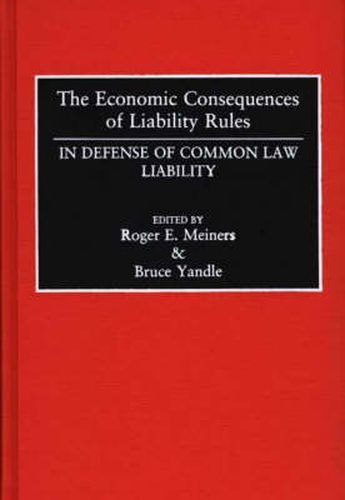Readings Newsletter
Become a Readings Member to make your shopping experience even easier.
Sign in or sign up for free!
You’re not far away from qualifying for FREE standard shipping within Australia
You’ve qualified for FREE standard shipping within Australia
The cart is loading…






Written by specialists in law and economics, this book studies the role of liability rules in an effort to illustrate the possible consequences of statutory tampering with them. The contributors explain how statutory and common law liability rules evolved, how they work in current practice, and how changes in rules can alter economic outcomes in significant and unintended ways. Although price theory is the primary analytical tool employed in the study, the contributors also provide a wealth of institutional detail intended to illuminate the structure and operation of forces at work when questions of product or service liability arise. Throughout, the contributors focus on the effects of individual decision making: how incentives faced by individuals are affected by liability rules and how the collective actions of purposeful individuals working in private markets and through the political process affect social outcomes. Among the specific topics addressed are using liability rules to deter government takings, the impact of government liability on private risk avoidance, the allocation of product liability by market share, liability and environmental quality, the effects of the flammability rule, deposit insurance and the savings and loan fiasco, and the political debate over automobile air bags. The contributors conclude that attempts to remedy alleged defects in the common law by legislative edict are not well grounded.
$9.00 standard shipping within Australia
FREE standard shipping within Australia for orders over $100.00
Express & International shipping calculated at checkout
Written by specialists in law and economics, this book studies the role of liability rules in an effort to illustrate the possible consequences of statutory tampering with them. The contributors explain how statutory and common law liability rules evolved, how they work in current practice, and how changes in rules can alter economic outcomes in significant and unintended ways. Although price theory is the primary analytical tool employed in the study, the contributors also provide a wealth of institutional detail intended to illuminate the structure and operation of forces at work when questions of product or service liability arise. Throughout, the contributors focus on the effects of individual decision making: how incentives faced by individuals are affected by liability rules and how the collective actions of purposeful individuals working in private markets and through the political process affect social outcomes. Among the specific topics addressed are using liability rules to deter government takings, the impact of government liability on private risk avoidance, the allocation of product liability by market share, liability and environmental quality, the effects of the flammability rule, deposit insurance and the savings and loan fiasco, and the political debate over automobile air bags. The contributors conclude that attempts to remedy alleged defects in the common law by legislative edict are not well grounded.